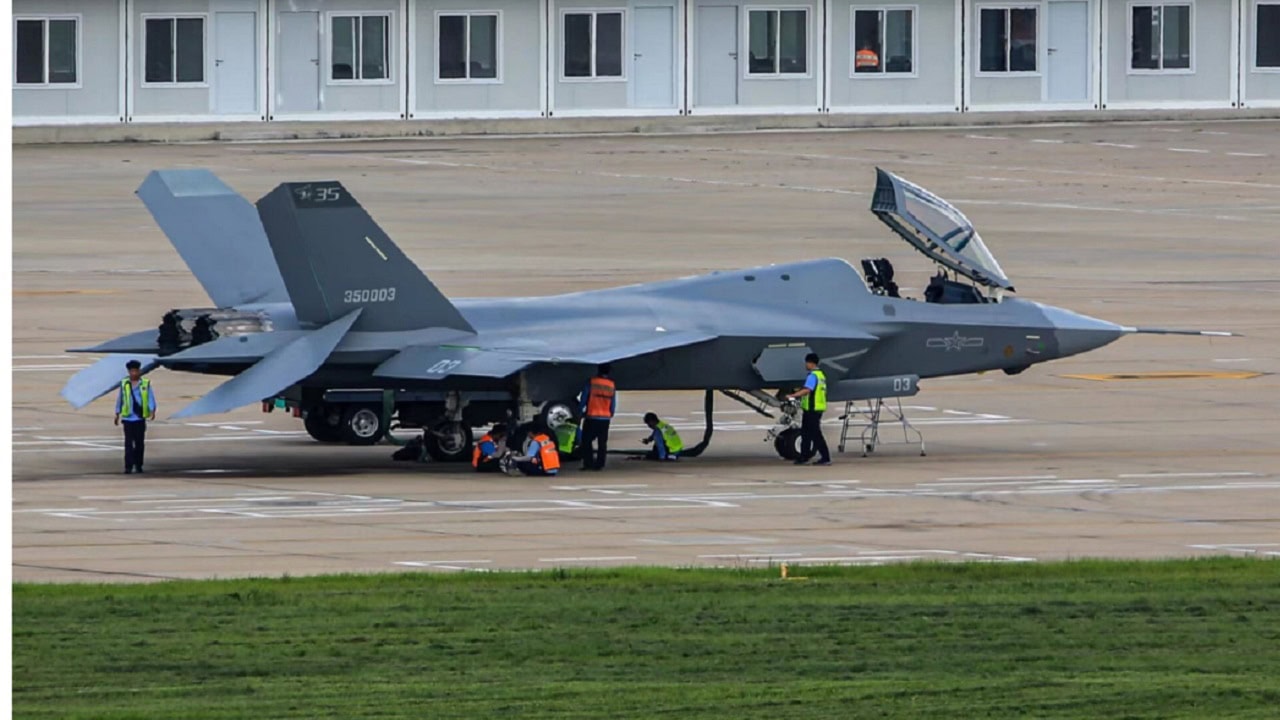Last week, an image circulated online showing a variant of the Chinese Shenyang FC-31 – also sometimes referred to as the J-35. It is believed to be the first high-resolution photo of the “prototype navalized derivative” of the fifth-generation stealth aircraft. The photo featured the aircraft with gray tactical paint and subdued national insignia, along with the identification number 35003.
“J-35 Prototype 350003 & Prototype 350001,” captioned David Wang (@Nickatgreat1220), who regularly reports on Chinese military hardware.
It was last October that the modified naval variant, which had been dubbed the J-35, made its maiden flight. It has been reported that the Naval variant aircraft is intended to operate from the newly-launched Fujian (Type 003) aircraft carrier via an electromagnetic Aircraft Launch System (ALS). This navalized variant is based on the second prototype of the FC-31 and features a catapult launch bar and wing-fold mechanism.
Very Detailed View
What makes last week’s photo of the J-35 especially remarkable is that it is the highest resolution – and thus highest detailed – image of the aircraft yet published online. While images of the aircraft, including in flight, have circulated, most were low-resolution and didn’t allow observers to see crucial details.
As TheDrive first reported, the images show the front opening, as well as an internally bowed canopy that is similar in design to the Lockheed Martin F-35 Lightning II – and suggest that the Chinese aircraft certainly was at least influenced by the design of the American-made stealth fighter. While the Chinese do not appear to be developing a short takeoff and vertical landing (STOVL) variant – similar to the F-35B – the J-35 still utilizes a canopy design similar to the Lightning II, which was designed to accommodate the lift fan used in the STOVL model.
A Good Facsimile … of the F-35
China has long copied – or at least reverse-engineered – all sorts of western products, so it isn’t surprising to believe that it copied a multitude of American design elements for its own fifth-generation fighter. However, Chinese hackers were also believed to have stolen multiple terabytes worth of data related to the F-35 program, including information on the Lightning II’s radar design – the number and types of modules used by the system – as well as its engine, including the method used for cooling gases, leading and trailing edge treatments, and aft deck heating contour maps.
Moreover, it was soon after the hack had been discovered that the FC-31 was first unveiled to the world, as a one-quarter scale model, at the China International Aviation & Aerospace Exhibition in 2012. A full-size airframe was officially introduced at the Zhuhai Airshow in November 2014.
J-35 Prototype 350003 & Prototype 350001 pic.twitter.com/3mhcXWRoKN
— David Wang (@Nickatgreat1220) July 22, 2022
The recent image posted online also shows that the J-35 could have received the new domestically-produced WS-21 engines, an improved variant or derivative of the WS-13E. Whether those engines can actually deliver the expected performance remains the big question. Any aircraft can look good on the ground, of course – especially in a high-resolution photo – but seeing it in flight will determine if the J-35 actually lives up to the hype.
A Senior Editor for 1945, Peter Suciu is a Michigan-based writer who has contributed to more than four dozen magazines, newspapers and websites. He regularly writes about military hardware, firearms history, cybersecurity and international affairs. Peter is also a Contributing Writer for Forbes. You can follow him on Twitter: @PeterSuciu.

